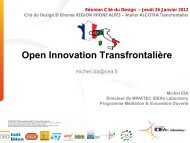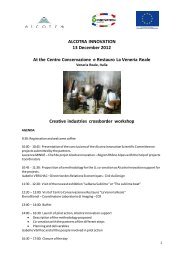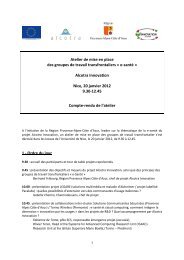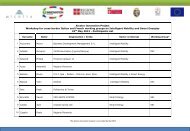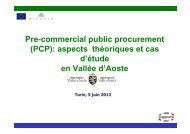Best practices Database for Living Labs - ALCOTRA - Innovation
Best practices Database for Living Labs - ALCOTRA - Innovation
Best practices Database for Living Labs - ALCOTRA - Innovation
You also want an ePaper? Increase the reach of your titles
YUMPU automatically turns print PDFs into web optimized ePapers that Google loves.
2. <strong>Living</strong> <strong>Labs</strong> as Territorial <strong>Innovation</strong> Models<br />
In line with some authoritative statements [2, 3], we can define <strong>Living</strong> <strong>Labs</strong> as territorial policy instruments<br />
where all the key stakeholders of R&D and innovation governance – namely firms, public authorities,<br />
universities and citizens – collectively <strong>for</strong>m a Public-Private-People-Partnership (PPPP) <strong>for</strong> the joint support<br />
and management of systemic innovation according to an open, user driven perspective. In particular, the<br />
PPPP members agree to collaborate in the co-creation, design, prototyping, validation and testing of new<br />
services, products and technologies, experimented by and with the end users in real-life contexts, thus<br />
achieving the preconditions <strong>for</strong> “democratizing the process of innovation” [4], at least at local and<br />
community level. There, the human being is seen as a source of improvement and sustainable change, not<br />
just like a consumer, a customer, or a ‘guinea pig’ <strong>for</strong> closed-door, classical prototype validation and<br />
verification activities. To adopt these principles in practice, several real-life experimentation pilots are set<br />
up and executed, which are normally and quite simply dubbed <strong>Living</strong> Lab’s trials.<br />
It is quite interesting to note that most initiators of the <strong>Living</strong> <strong>Labs</strong> ‘movement’ in Europe actually operated<br />
in urban [5] and mobile [6] environments, either to increase the participation of citizens in spatial planning<br />
decision making or to implement User Centred Design (UCD) techniques into R&D on ubiquitous computing<br />
technologies. Although the ‘Mobile City’ – and more recently ‘Smart City’ – concept can be seen as quite<br />
transversal to many experiences, it is in regional development policy design that the extended stakeholders<br />
engagement within a <strong>Living</strong> Lab’s PPPP can really mark a visible difference with respect to the UCD and<br />
Participatory Decision-Making (PDM) approaches. In fact, the main impact of <strong>Living</strong> <strong>Labs</strong> is to increase the<br />
economic and social attractiveness of the territory they belong to, especially by improving the conditions of<br />
ICT-enabled systemic innovation [7].<br />
This, however, requires the unification and coordination of several independent ef<strong>for</strong>ts from the local<br />
stakeholders, while bringing about a great deal of advantages. In particular, the involvement of citizens and<br />
businesses helps to strengthen a culture of innovation and to raise the awareness of policy makers towards<br />
the socioeconomic value of infrastructure investments (such as broadband); the cultural commitment to<br />
the so-called ‘<strong>Living</strong> Labbing’ leads to a permanent improvement of innovation capacity in both mature and<br />
emerging markets. At the end of the day, this calls <strong>for</strong> an integrated, cross-sectorial, and also possibly crossdomain<br />
approach to the governance of innovation, growth and development in a given area, which can<br />
hardly be achieved without electronic means [8].<br />
Typically, the ‘birth announcement’ of a <strong>Living</strong> Lab coincides with pilot users, researchers, policy makers<br />
and businesses at local level entering into agreements, on the basis of which they engage in a long-term<br />
collaboration and commit to practicing user driven, open innovation [9]. Thus, we may assimilate a <strong>Living</strong><br />
Lab to a multi-stakeholder plat<strong>for</strong>m, though it can also happen that the original PPPP gets structured into a<br />
conventional legal <strong>for</strong>m.<br />
A widely accepted definition [10] describes a multi-stakeholder plat<strong>for</strong>m as a (voluntary or statutory) body,<br />
comprising different stakeholders, who perceive the same problem, realize their own respective<br />
interdependencies, and come together to agree on the best action strategies <strong>for</strong> solving it. It is like a<br />
roundtable, where people are gathered with very different perspectives. Examples of such a plat<strong>for</strong>m do<br />
abound in several, rather independent policy contexts – from Millennium Development to natural resource<br />
management and environmental assessment, from participatory urban planning to the deployment of<br />
In<strong>for</strong>mation Society. Some plat<strong>for</strong>ms are promoted and supported by public decision-makers; some others<br />
just aggregate and develop spontaneously.<br />
When people come together in such plat<strong>for</strong>ms, they hold multi-stakeholder dialogues, which instantiate<br />
themselves into one or more collaboration experiments (trials). Basically, the multi-stakeholder dialogue is<br />
not just a conversation model, but an interactive approach to get things done - a contrived situation in<br />
which a set of (more or less) interdependent stakeholders are identified and invited to meet and interact to<br />
The project is co-funded by the ERDF<br />
Page 9 of 78



